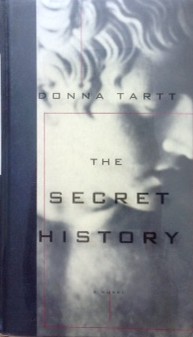Inspiring Older Readers
 posted on 02 Jun 2017
posted on 02 Jun 2017
The Secret History by Donna Tartt
First published in 1992, The Secret History, Tartt’s first novel was a smash hit from the outset. Compared to other first novels which have quite limited first edition print runs, The Secret History had a first edition of 75,000 copies and they sold out rapidly. The book and the writer quickly developed a cult status which Tartt has sustained despite the relatively lukewarm critical responses her subsequent novels have attracted. She is notoriously finicky about detail in her books and so she writes very slowly – currently managing a book every ten years or so.
When I first read The Secret History two or three years after its publication date I quickly fell under its spell. I was transfixed by the storytelling in a way that felt compulsive – you simply had to turn the next page to find out what was coming next. The writing felt easy and yet it didn’t seem to compromise on the literary merits that appeared to raise it above the more populist blockbusters. I have found that mentioning Tartt’s book to other people who are also keen readers nearly always inspires some kind of enthusiastic, even rapturous, response and this says a lot about just how broadly popular this book is.
So going back to it again after all these years was always going to be an interesting experience. I had found that rereading other books that I had thought impossible to put down the first time around were sometimes disappointing or even unreadable on a second look. They hadn’t changed of course but I most certainly had. I think that I have tended to underestimate the way in which I, as the reader, had constructed an atmosphere, order and even structure that I found wasn’t automatically there again on the rereading. This idea, that the reader is the co-producer of the book, has become an increasingly important concept for me over recent years as I’ve returned to books I love only to be disappointed.
And so it turns out for The Secret History. This is a book that is devilishly difficult to review in terms of the storyline because it’s almost impossible not to fill the page with plot spoilers. Suffice it to say that this is a murder mystery where it’s not a question of who did it but why they did it. From the outset we know that a young man, Bunny, a member of a small elite and privileged group of students is killed by some or all of the rest of them and that this is going to be a book that unwraps that story.
The narrative is told in flashback by Richard Papen who is the last to join the group and who because of his background and lack of privilege will always be an observer, hovering both inside and outside the core who seem to be much more bonded. The story unfolds like unpeeling the rings of an onion and what seems to be a tale of cabalistic friendship is gradually revealed to be anything but that. The events and revelations leading up to the killing begin to bring the mystery more and more into focus and we see everything through the eyes of Richard, only being fed the jigsaw pieces at the same time as he is. As he begins to see the horrors that underpin the situation the group has found itself in, we too can see that this first killing is only the starting point for a full blown tragedy. From this point onwards the story sets out the details of the collapse of the group and its spiral downwards towards a denouement that wouldn’t be out of place in a Shakespearean tragedy.
I know I haven’t told you very much about a storyline that takes 500 pages to unfold but believe me, saying more would certainly rob you of the frisson of discovery – and that’s essential to an enjoyment of the book.
It seems to me the mystery at the heart of the story is the key part of the book’s magnetic appeal – it makes a bond with the reader that is definitely considerably weaker once you’ve read it and know what’s going on. Essentially the secret is the genie in the bottle and once it’s out, it’s out. Because of this, reading it for a second time leaves you free to concentrate on things other than plot and this is not, in my view, to the advantage of the author. What does come into focus are the improbabilities of the plot, the sometimes wooden characterisation and the over-wrought melodrama of the second half of the novel. So too does Tartt’s rather heavy handed homage to Fitzgerald’s The Great Gatsby - and where homage becomes pastiche is sometimes hard to tell here.
Recently a friend of mine, Alun Severn, who also reviews books for this website said that he was concerned that if he were to reread The Secret History he might find it ‘adolescent’ and this turned out to be a really perceptive insight. That’s not to say that the writing is adolescent – it’s not, I still think that despite its shortcomings it’s a dazzling piece of work from a technical perspective – but that its natural audience is likely to be those who are young and enthusiastic and keen to find a well written, literary thriller that has a hint of the forbidden and exotic. And there’s nothing wrong with any of that.
It’s just that that’s not me any more.
Terry Potter
June 2017